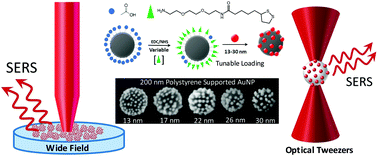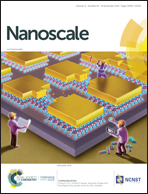Preparation of polymer gold nanoparticle composites with tunable plasmon coupling and their application as SERS substrates†
Abstract
The controlled surface functionalisation of polystyrene beads (200 nm) with a lipoic acid derivative is used to assemble composites with between 4 to 20% loadings of citrate stabilised gold nanoparticles (13 nm–30 nm), which exhibit variable optical properties arising from interactions of the nanoparticle surface plasmon resonance (SPR). The decrease in average interparticle distance at higher loadings results in a red-shift in the SPR wavelength, which is well described by a universal ruler equation. The composite particles are shown to act as good SERS substrates for the standard analyte 4-mercaptophenol. The direct assessment of the SERS activity for individual composite particles solution is achieved by Raman optical tweezer measurements on 5.3 μm composite particles. These measurements show an increase in performance with increasing AuNP size. Importantly, the SERS activity of the individual particles compares well with the bulk measurements of samples deposited on a surface, indicating that the SERS activity arises primarily from the composite and not due to composite–composite interactions. In both studies the optimum SERS response is obtained with 30 nm AuNPs.



 Please wait while we load your content...
Please wait while we load your content...